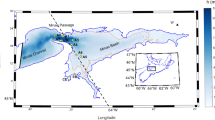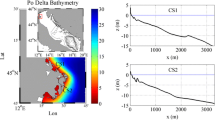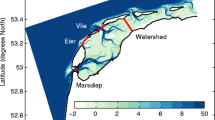Abstract
Suspended particulate matter (SPM) fluxes and dynamics are investigated in the East Frisian Wadden Sea using a coupled modeling system based on a hydrodynamical model [the General Estuarine Transport Model (GETM)], a third-generation wave model [Simulating Waves Nearshore (SWAN)], and a SPM module attached to GETM. Sedimentological observations document that, over longer time periods, finer sediment fractions disappear from the Wadden Sea Region. In order to understand this phenomenon, a series of numerical scenarios were formulated to discriminate possible influences such as tidal currents, wind-enhanced currents, and wind-generated surface waves. Starting with a simple tidal forcing, the considered scenarios are designed to increase the realism step by step to include moderate and strong winds and waves and, finally, to encompass the full effects of one of the strongest storm surges affecting the region in the last hundred years (Storm Britta in November 2006). The results presented here indicate that moderate weather conditions with wind speeds up to 7.5 m/s and small waves lead to a net import of SPM into the East Frisian Wadden Sea. Waves play only a negligible role during these conditions. However, for stronger wind conditions with speeds above 13 m/s, wind-generated surface waves have a significant impact on SPM dynamics. Under storm conditions, the numerical results demonstrate that sediments are eroded in front of the barrier islands by enhanced wave action and are transported into the back-barrier basins by the currents. Furthermore, sediment erosion due to waves is significantly enhanced on the tidal flats. Finally, fine sediments are flushed out of the tidal basins due to the combined effect of strong erosion by wind-generated waves and a longer residence time in the water column because of their smaller settling velocities compared to coarser sediments.

















Similar content being viewed by others
Notes
To transform the mass change of bottom sediment into a change in the thickness of the bottom sediment layer, the porosity of the sediment must be considered. With the mass change ΔM measured in kilograms per square meter, the sediment density ρ S , and sediment porosity ϕ, the elevation change Δz is calculated by Δz = ΔM/((1 − ϕ) ρ S ).
References
Austen I, Witte G (2000) Comparison of the erosion shear stress of oxic and anoxic sediments in the East Frisian Wadden sea. In: Flemming BW et al (ed) (2000) Muddy coast dynamics and resource management. Proceedings in Marine Science, vol 2. Elsevier, Amsterdam, pp 75–84
Badewien TH, Zimmer E, Bartholomä A, Reuter R (2009) Time series measurements of suspended particulate matter (SPM) in turbid coastal waters. Ocean Dyn. doi:10.1007/s10236-009-0183-8
Bartholdy J, Anthony D (1998) Tidal dynamics and seasonal dependent import and export of fine-grained sediment through a backbarrier tidal channel of the Danish Wadden Sea. In: Tidalities: processes and products, SEPM, special publication, vol 61. SEPM, Tulsa, pp 43–52
Bassoullet P, Le Hir P, Gouleaub D, Robert S (2000) Sediment transport over an intertidal mudflat: field investigations and estimation of fluxes within the ’Baie de Marenngres-Oleron’ (France). Cont Shelf Res 20:1635–1653
Blaas M, Changming D, Marchesiello P, McWilliams JC, Stolzenbach K (2007) Sediment-transport modeling on southern californian shelves: a ROMS case study. Cont Shelf Res 27:832–853
Booij N, Ris RC, Holthuijsen LH (1999) A third-generation wave model for coastal regions 1. model description and validation. J Geophys Res 104:7649–7666
Burchard H, Bolding K (2002) GETM—a general estuarine transport model. Sci Doc EUR 20253 EN, Inst for Environ and Sustainability, Ispra, Italy
Burchard H, Bolding K, Villarreal MR (1999) GOTM—a general ocean turbulence model. theory, applications and test cases. Tech Rep EUR 18745 EN, European Commission
Burchard H, Bolding K, Villereal M (2004) Three-dimensional modelling of estuarine turbidity maxima in a tidal estuary. Ocean Dyn 54:250–265
Burchard H, Bolding K, Umlauf L (2007) GETM—General Estuarine Transport Model, source code and test case documentation. http://www.getm.eu
Burchard H, Flöser G, Staneva J, Badewien TH, Riethmüller R (2008) Impact of density gradients on net sediment transport into the wadden sea. J Phys Oceanogr 38:566–587
Cavaleri L, Malanotte-Rizzoli P (1981) Wind wave prediction in shallow water: theory and application. J Geophys Res 86:10961–10973
Chang TS, Joerdel O, Flemming BW, Bartholomä A (2006) The role of particle aggregation/disaggregation in muddy sediment dynamics and seasonal sediment turnover in a back-barrier tidal basin, East Frisian Wadden Sea, southern North Sea. Mar Geol 235:49–61
Condie SA, Sherwood CR (2006) Sediment distribution and transport across the continental shelf and slope under idealized wind forcing. Prog Oceanogr 70:255–270
Einstein HA, Krone RB (1962) Experiments to determine modes of cohesive sediment transport in salt water. J Geophys Res 67:1451–1461
Emeis S, Türk M (2009) Wind-driven wave heights in the German Bight. Ocean Dyn. doi:10.1007/s10236-008-0178-x
ETOPO2 (2006) 2-minute Gridded Global Relief Data (ETOPO2v2). US Department of Commerce, National Oceanic and Atmospheric Administration, National Geophysical Data Center
Flemming BW, Nyandwi N (1994) Land reclamation as a cause of fine-grained sediment depletion in backbarrier tidal flats (southern North Sea). Neth J Aquat Ecol 28:299–307
Flemming BW, Ziegler K (1995) High-resolution grain size distribution patterns and textural trends in the backbarrier environment of Spiekeroog Island (southern North Sea). Senckenb Marit 26:1–24
Gayer G, Dick S, Pleskachevsky A, Rosenthal W (2006) Numerical modeling of suspended matter transport in the north sea. Ocean Dyn 56:62–77
Holthuijsen LH (2007) Waves in Oceanic and Coastal Waters. Cambridge Univesity Press, Cambridge
Kalnay et al (1996) The NCEP/NCAR 40-year reanalysis project. Bull Am Meteorol Soc 77:437–470
Komen G, Hasselmann K, Hasselmann K (1984) On the existence of a fully developed wind-sea spectrum. J Phys Oceanogr 14:1271–1285
Krögel F, Flemming BW (1998) Evidence for temperature-adjusted sediment distributions in the back-barrier tidal flats of the East Frisian Wadden Sea (southern North Sea). In: Alexander CR, Davis RA, Henry VJ (eds) In: Tidalities: processes and products, SEPM, special publication, vol 61. SEPM, Tulsa, pp 31–41
Liang BC, Li HJ, Lee DY (2007) Numerical study of three-dimensional suspended sediment transport in waves and currents. Ocean Eng 34:1569–1583
Loewe P, Klein H, Becker G, Nies H, Brockmann U, Schmolke S, Dick S, Schrader D, Frohse A, Schulz A, Herrmann J, Theobald N, Klein B, Weigelt S (2006) Nordseezustand 2004. Berichte des Bundesamtes für Seeschifffahrt und Hydrographie (BSH) 40
Partheniades E (1965) Erosion and deposition of cohesive soils. Proc ASCE J Hydraul Div 91:105–139
Pleskachevsky A, Gayer G, Horstmann J, Rosenthal W (2005) Synergy of satellite remote sensing and numerical modeling for monitoring of suspended particulate matter. Ocean Dyn 55:2–9
Roberts W, Le Hir P, Whitehouse RJS (2000) Investigation using simple mathematical models of the effect of tidal currents and waves on the profile shape of intertidal mudflats. Cont Shelf Res 20:1079–1097
Santamarina Cuneo P, Flemming BW (2000) Quantifying concentration and flux of suspended particulate matter through a tidal inlet of the East Frisian Wadden Sea by acoustic doppler current profiling. In: Flemming, BW et al (eds) (2000) Muddy coast dynamics and resource management. Proceedings in Marine Science vol 2. Elsevier, Amsterdam, pp 39–52
Soulsby R (1997) Dynamics of marine sands. a manual for practical applications. Thomas Telford, London
Soulsby R, Whitehouse R (1997) Threshold of sediment motion in coastal environments. Proc Pacific Coasts and Ports ’97 Conf, Christchurch, 1, University of Canterbury, New Zealand pp 149–154
Stanev EV, Wolff J-O, Burchard H, Bolding K, Flöser G (2003) On the circulation in the East Frisian Wadden Sea: numerical modeling and data analysis. Ocean Dyn 53:27–51
Stanev EV, Flöser G, Wolff J-O (2003b) First- and higher-order dynamical controls on the water exchanges between tidal basins and the open ocean. a case study for the East Frisian Wadden Sea. Ocean Dyn 53:146–165
Stanev EV, Wolff J-O, Brink-Spalink G (2006) On the sensitivity of the sedimentary system in the East Frisian Wadden Sea to sea-level rise and wave-induced bed shear stress. Ocean Dyn 56:266–283
Stanev EV, Brink-Spalink G, Wolff J-O (2007) Sediment dynamics in tidally dominated environments controlled by transport and turbulence: a case study for the East Frisian Wadden Sea. J Geophys Res 112
Staneva J, Stanev EV, Wolff J-O, Badewien TH, Reuter R, Flemming B, Bartholomä, Bolding K (2008) Hydrodynamics and sediment dynamics in the German Bight. A focus on observations and numerical modelling in the East Frisian Wadden Sea. Cont Shelf Res 29(1):302–319
Umweltatlas Wattenmeer (1999) Band 2, Wattenmeer zwischen Elb- und Emsmündung. Ulmer Verlag Stuttgart, Germany
van Straaten LMJU, Kuenen PH (1957) Accumulation of fine grained sediments in the Dutch Wadden Sea. Geol Mijnb 19:329–354
Warner JC, Butman B, Soupy Dalyander P (2008) Storm-driven sediment transport in Massachusetts bay. Cont Shelf Res 28:257–282
Acknowledgements
This model study was highly dependent on external data sources. Therefore, we are grateful to Ralf Berger from the Federal Maritime and Hydrographic Agency (BSH, Bundesamt für Seeschifffahrt und Hydrographie) for providing the wave data from the wave buoys in the German Bight; Heike Gentz and Michael Hesse from BSH and Ralf Kaiser from NLWKN (Niedersächsischer Landesbetrieb für Wasserwirtschaft, Küsten- und Naturschutz) for bathymetric data; and, finally, Adam Kubicki (Forschungsinstitut Senckenberg, Department of Marine Science) for providing us with wave data from the time-series station. Furthermore, we want to mention the helpful discussions with Alexander Bartholomä, Burghard Flemming, Jöran März, Ulf Gräwe, Joanna Staneva, and Emil Stanev. Last but not least, we thank two anonymous reviewers, whose thoughtful comments helped to improve the quality of the manuscript. This study was embedded within the research group ’Biogeochemistry of tidal flats’, which was funded by the Deutsche Forschungsgemeinschaft (DFG).
Author information
Authors and Affiliations
Corresponding author
Additional information
Responsible Editor: Ulrike Feudel
Appendix
Appendix
1.1 SPM transport module
The SPM transport module used in this study is described in more detail. For each sediment fraction c i, the usual diffusion–advection equation can be written as
Here, u, v, and w denote current speeds in the three cartesian directions; \(w^i_s\) denotes the settling velocity of the i th particle fraction; and A v and A h denote the vertical and horizontal eddy diffusivity.
While the horizontal diffusivity A h was set constant, the vertical diffusivity A v was a combination of three components:
\(A_v^t(z)\) accounted for the vertical turbulent diffusion induced by the current field and was calculated by the General Ocean Turbulence Model (GOTM, Burchard et al. 1999), which is part of the GETM model. \(A_v^b\) denotes the constant background diffusivity, which, in contrast to the turbulent diffusivity \(A_v^t(z)\), was also present when there was no motion of the water column. In this model study, a value of \(A_v^b = 1.0 \cdot 10^{-6}\) m2/s was used.
To include the effect of surface gravity waves on the vertical diffusion of SPM, a parameterization proposed by Pleskachevsky et al. (2005) was implemented, which is based on the wave induced-orbital velocity field:
Here, H sig denotes the significant wave height, T peak the peak period of the underlying wave spectrum, k the corresponding wave number according to the dispersion relation of surface gravity waves (a formula to calculate the wave number is given below in Eq. 18), and U w (z) the amplitude of the wave-induced orbital velocity, which is given by:
where h denotes the water depth measured downward from the surface (the bottom level is z = − h).
The settling velocity of the i th particle fraction was calculated after a formula from Soulsby (1997), which is valid for noncohesive irregular sand grains (Table 3):
Here, g denotes the acceleration due to gravity, ρ s and ρ W the sediment and water density in kilograms per cubic meter, ν the kinematic viscosity in square meters per second, and d the sediment diameter in meters (see left graph in Fig. 18).
The temperature dependency of the kinematic viscosity ν was calculated by:
with temperature T in o C, η = 1.9909 · 10 − 6 kg/(ms), and b = 1.8284 · 103 K.
In the vertical direction, sediment only entered and left the water column through the bottom boundary layer, for which the following sediment flux condition was used:
Here, F ero and F dep denote the sediment fluxes at the bottom due to erosion and deposition.
According to Einstein and Krone (1962), the deposition flux was calculated with:
Here, τ B denotes the bottom shear stress and \(\tau^i_c\) a critical shear stress, which had to be reached by the fluid in order to erode sediment from the bottom into the water column. If the bottom shear stress was below that value, suspended sediment settled to the bottom. Soulsby and Whitehouse (1997) provided an empirical formula for that critical shear stress, which is given by (Table 3):
In Fig. 18, the critical shear stress is depicted for two different water temperatures. It is evident from this figure that the critical shear stresses used in this study are of the same order as those reported by Austen and Witte (2000) for sandy sediments in the Wadden Sea region. However, these values do not account for muddy and cohesive sediments, which have higher critical shear stresses of about 0.5–1.0 N/m2. This effect will be implemented in a future study.
Furthermore, to determine the critical shear stress for a particular sediment fraction, the bottom sediments were modeled as separate pools that did not interact with each other. Therefore, the different sediment fractions were eroded and deposited separately from each other without accounting for mean grain size and mean critical shear stress at a specific location.
The erosion flux was calculated according to the formula of Partheniades (1965):
M e is a free parameter that can be adapted to measurements of sediment concentration. For their studies in the East Frisian Wadden Sea, Stanev et al. (2006) used a value of \(M_e=3.7 \cdot 10^ {-6} \mbox { kg}/(\mbox{m}^2 \mbox{s})\).
Total bottom shear stress responsible for sediment erosion and deposition was modeled as a nonlinear combination of a current-induced component τ current and a wave-induced component τ wave (Soulsby 1997). This approach was also used by Pleskachevsky et al. (2005) and Gayer et al. (2006):
Here, ϕ denotes the angle between the direction of wave propagation and current flow.
The current-induced bottom shear stress was calculated in GETM via an iterative procedure with a prescribed constant bottom roughness length z 0 (see more details in Burchard and Bolding (2002)).
The wave-induced component was calculated after an approach proposed by Soulsby (1997). This approach begins with a general relation for bottom shear stress due to surface gravity waves:
Here, f w denotes the wave friction factor, ρ W the water density, and U w the horizontal wave orbital velocity near the bottom just above the wave boundary layer. The bottom velocity was approximated by:
which is the bottom velocity expression of Airy-waves. Here, h denotes the water depth, H sig the wave height, T peak the wave period, and k the corresponding wave number.
In general, the wave number is related to the peak period by the dispersion relation of surface gravity waves:
However, as it is not straightforward to obtain the wave number k from this dispersion relation if only T peak is known, a simple estimation provided by Soulsby (1997) was used in this study:
The wave friction factor f w was calculated for f ws in the case of smooth beds or f wr in the case of rough beds by:
The bottom roughness was calculated by z 0 = d 50/12 and the semiorbital excursion A was given by A = U w T peak / (2 π). The parameters of the smooth bed friction factor f ws were dependent on the turbulence of the motion, which could be determined from the wave Reynolds number R w = U w A / ν. According to this number, the parameters N and B were calculated by:
Finally, if sediments were deposited at or eroded from the bottom, the mass of the available sediment pools changed. Each bottom pool \(P_B^i\) was changed according to the following equation:
Rights and permissions
About this article
Cite this article
Lettmann, K.A., Wolff, JO. & Badewien, T.H. Modeling the impact of wind and waves on suspended particulate matter fluxes in the East Frisian Wadden Sea (southern North Sea). Ocean Dynamics 59, 239–262 (2009). https://doi.org/10.1007/s10236-009-0194-5
Received:
Accepted:
Published:
Issue Date:
DOI: https://doi.org/10.1007/s10236-009-0194-5





